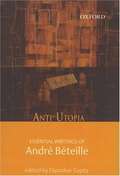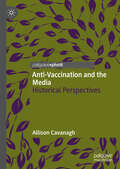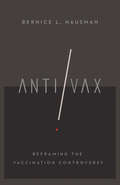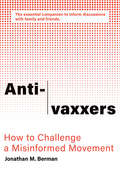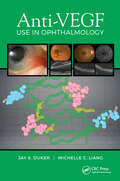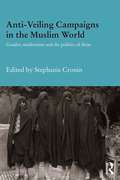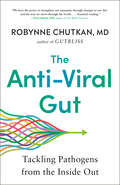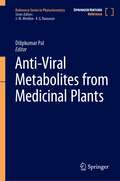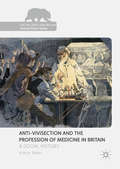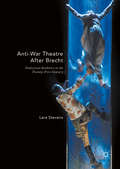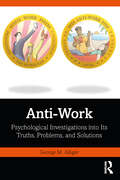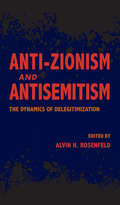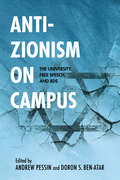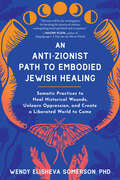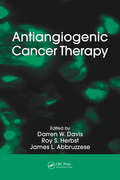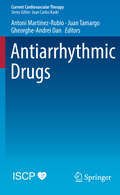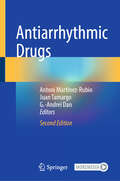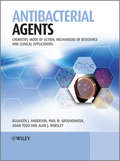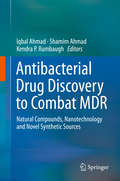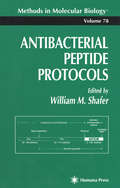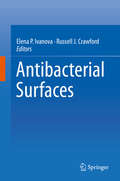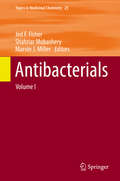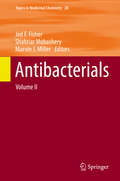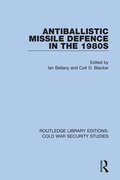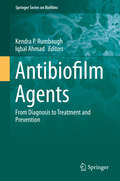- Table View
- List View
Anti-Utopia: Essential Writings of André Béteille
by Dipankar Gupta André BéteilleThe 18 selected essays from the work of India's most outstanding sociologist deal with religion, caste, gender, as well as class and status.
Anti-Vaccination and the Media: Historical Perspectives
by Allison CavanaghThis book explores narratives of vaccine hesitancy using samples from the UK press, and looks at the ways these have changed between the 1950s and the present. The work draws on a variety of research instruments including semantic network analysis and analysis of metaphor to provide a rich description of anti-vaccine narratives in different historical periods. The work considers the ways that concerns about and resistance to inoculation were informed by cultural and social pressures in two case studies, firstly that of polio in the 1950s and secondly the so called ‘pertussis crisis’ of the 1970s, wherein a period of social activism and newspaper campaigning led UK and US governments to offer compensation schemes for vaccine damaged children. The studies chosen provide a detailed comparison of the politics of childhood inoculation over two eras in the UK. Chapters also cover the use of metaphor and representational analysis in health communication, comparing ways in which the work of Moscovici, Sontag and other theorists can be used to provide complementary insights, and the affordances and concerns around the use of ‘big data’ analyses in historical work. The work also features discussion of the implications of the findings for approaches to more recent vaccination crisis points. This book argues that anti-vaccination narratives, far from showing a stable and coherent set of concerns, are highly mutable. The work compares anti-vaccination and conspiracy theory narratives, drawing out areas of continuity and schism.
Anti/Vax: Reframing the Vaccination Controversy (The Culture and Politics of Health Care Work)
by Bernice L. HausmanAntivaxxers are crazy. That is the perception we all gain from the media, the internet, celebrities, and beyond, writes Bernice Hausman in Anti/Vax, but we need to open our eyes and ears so that we can all have a better conversation about vaccine skepticism and its implications.Hausman argues that the heated debate about vaccinations and whether to get them or not is most often fueled by accusations and vilifications rather than careful attention to the real concerns of many Americans. She wants to set the record straight about vaccine skepticism and show how the issues and ideas that motivate it—like suspicion of pharmaceutical companies or the belief that some illness is necessary to good health—are commonplace in our society.Through Anti/Vax, Hausman wants to engage public health officials, the media, and each of us in a public dialogue about the relation of individual bodily autonomy to the state's responsibility to safeguard citizens' health. We need to know more about the position of each side in this important stand-off so that public decisions are made through understanding rather than stereotyped perceptions of scientifically illiterate antivaxxers or faceless bureaucrats. Hausman reveals that vaccine skepticism is, in part, a critique of medicalization and a warning about the dangers of modern medicine rather than a glib and gullible reaction to scaremongering and misunderstanding.
Anti-vaxxers: How to Challenge a Misinformed Movement
by Jonathan M. BermanFrom science advocate and March on Science National Co-Chair Jonathan M. Berman, an essential takedown of the anti-vaccination movement, from its nineteenth-century antecedents to today's Facebook activists, offering strategies for refuting false claims of friends and family.Vaccines are a documented success story, one of the most successful public health interventions in history. Yet there is a vocal anti-vaccination movement, featuring celebrity activists (including Kennedy scion Robert F. Kennedy Jr. and actress Jenny McCarthy) and the propagation of anti-vax claims through books, documentaries, and social media. In Anti-Vaxxers, Jonathan Berman explores the phenomenon of the anti-vaccination movement, recounting its history from its nineteenth-century antecedents to today's activism, examining its claims, and suggesting a strategy for countering them.
Anti-VEGF Use in Ophthalmology
by Jay Duker Michelle LiangThe introduction of anti-vascular endothelial growth factor (VEGF) agents has revolutionized therapy for a host of ocular diseases associated with leakage from normal blood vessels and pathologic blood vessel growth. Anti-VEGF Use in Ophthalmology is an all-inclusive reference designed to provide detailed, up-to-date, and clinically relevant information on the current use of anti-VEGF agents in the treatment of all ocular conditions. Drs. Jay S. Duker and Michelle C. Liang have assembled a prestigious group of contributors who pool their collective expertise in this comprehensive book. Anti-VEGF Use in Ophthalmology is split into two sections with the first providing the history of VEGF and an overview of anti-VEGF agents and different routes of drug delivery, as it is important for eye care providers to be familiar with up-to-date aspects of the medications and indications for use. The second section details the clinical uses of anti-VEGF agents in numerous ocular diseases, from the anterior segment including cornea and glaucoma to uveitis and various retinal and choroidal diseases. Each chapter in this section summarizes the disease process and utilizes high-quality ocular imaging to demonstrate the therapeutic use of the anti-VEGF agents. Some of the topics covered in Anti-VEGF Use in Ophthalmology: Neovascular Age-Related Macular Degeneration Proliferative Diabetic Retinopathy Retinal Vein Occlusion Uveitis Neovascular Glaucoma Macular Edema Retinopathy of Prematurity Corneal Disease Anti-VEGF Use in Ophthalmology combines the theory and applications of anti-VEGF agents, making it not only a great learning tool for beginners but also a useful reference tool for a wide range of eye care professionals including optometrists, residents, comprehensive ophthalmologists, as well as specialists in anterior segment, pediatrics, and vitreoretinal disease.
Anti-Veiling Campaigns in the Muslim World: Gender, Modernism and the Politics of Dress (Durham Modern Middle East and Islamic World Series)
by Stephanie CroninIn recent years bitter controversies have erupted across Europe and the Middle East about women’s veiling, and especially their wearing of the face-veil or niqab. Yet the deeper issues contained within these controversies – secularism versus religious belief, individual freedom versus social or family coercion, identity versus integration – are not new but are strikingly prefigured by earlier conflicts. This book examines the state-sponsored anti-veiling campaigns which swept across wide swathes of the Muslim world in the interwar period, especially in Turkey and the Balkans, Iran, Afghanistan and the Soviet republics of the Caucasus and Central Asia. It shows how veiling was officially discouraged and ridiculed as backward and, although it was rarely banned, veiling was politicized and turned into a rallying-point for a wider opposition. Asking a number of questions about this earlier anti-veiling discourse and the policies flowing from it, and the reactions which it provoked, the book illuminates and contextualizes contemporary debates about gender, Islam and modernism.
The Anti-Viral Gut: Tackling Pathogens from the Inside Out
by Robynne ChutkanA practical plan for strengthening the incredible antiviral defenses located in your gut and resolving symptoms—from a renowned gastroenterologist and the author of Gutbliss.Multiple studies have now confirmed a dramatic link between the health of our microbiome—the trillions of bacteria that live in our digestive tract—and our likelihood of getting devastating viral illnesses like COVID-19. Low-fiber diets, limited exposure to nature, and overzealous use of pharmaceuticals have messed up our microbiome, making many of us more susceptible to viruses than we naturally should be. But the good news is that unlike our genes, our microbiome is constantly evolving, offering a pathway back to health for those who are suffering, and proven protection for those who want to stay well. In The Anti-Viral Gut, Dr. Robynne Chutkan explains this groundbreaking research and offers a prescriptive plan for anyone trying to avoid or recover from a viral illness to rehab their gut microbes and restore their health. In this powerful road map to strengthening the gut-immune system, Chutkan gives practical advice for balancing both your internal and external environment by optimizing diet, exercise, sleep, and time outdoors to boost your host defenses and overall health. The Anti-Viral Gut includes: a step-by-step nutrition plan, including recipes to improve your good gut bacteria and an explanation of which foods and preparation methods bring you the fastest resultsprotocols for replacing immune-suppressive, microbiome-disruptive medications with safer alternativesguidelines for exercise, sleep hygiene, and stress reduction methods for working mindfulness, breathwork, and meditation into your daily routineadvice on maximizing the potent antiviral effects of nature Complete with inspiring stories from Dr. Chutkan&’s own patients who have battled COVID-19, The Anti-Viral Gut will empower readers to jump-start their journey toward healing.
Anti-Viral Metabolites from Medicinal Plants (Reference Series in Phytochemistry)
by Dilipkumar PalThis reference work covers general concepts of anti-viral metabolites, classifications, ethnopharmacology, chemistry, clinical and preclinical studies focusing on different medicinal plants against various types of viral infections. Various plants have been used in medicine since ancient times and are known for their strong therapeutic effects. The book will describe potential antiviral properties of medicinal plants against a diverse group of viruses, and provide an insight to the potential plants possess for broad-spectrum antiviral effects against emerging viral infections. The book aims to target a broad audience including virologists, molecular biologist, microbiologist and scientists working with natural products as well as researchers, students, healthcare experts involved in pharmaceutical and medical field.
Anti-Vivisection and the Profession of Medicine in Britain: A Social History (The Palgrave Macmillan Animal Ethics Series)
by A.W.H. BatesThis book is open access under a CC BY 4. 0 license. This book explores the social history of the anti-vivisection movement in Britain from its nineteenth-century beginnings until the 1960s. It discusses the ethical principles that inspired the movement and the socio-political background that explains its rise and fall. Opposition to vivisection began when medical practitioners complained it was contrary to the compassionate ethos of their profession. Christian anti-cruelty organizations took up the cause out of concern that callousness among the professional classes would have a demoralizing effect on the rest of society. As the nineteenth century drew to a close, the influence of transcendentalism, Eastern religions and the spiritual revival led new age social reformers to champion a more holistic approach to science, and dismiss reliance on vivisection as a materialistic oversimplification. In response, scientists claimed it was necessary to remain objective and unemotional in order to perform the experiments necessary for medical progress.
Anti-War Theatre After Brecht: Dialectical Aesthetics in the Twenty-First Century
by Lara StevensExaminingthe ways in which contemporary Western theatre protests against the 'War onTerror', this book analyses six twenty-first century plays that respond to thepost-9/11 military operations in Afghanistan, Iraq and Palestine. The plays arewritten by some of the most significant writers of this century and the lastincluding Elfriede Jelinek, Caryl Churchill, Hélène Cixous andTony Kushner. Anti-war Theatre After Brecht grapples with theproblem of how to make theatre that protests the policies of democraticallyelected Western governments in a post-Marxist era. It shows how the Internethas become a key tool for disseminating anti-war play texts and how onlinesocial media forums are changing traditional dramatic aesthetics and broadeningopportunities for spectator access, engagement and interaction with a work andthe political alternatives it puts forward.
Anti-Work: Psychological Investigations into Its Truths, Problems, and Solutions
by George M. AlligerThe first book to delineate anti-work in a systematic fashion by identifying and compiling positions from a wide spread of literature, Anti- Work: Psychological Investigations into Its Truths, Problems, and Solutions defines the tenets of anti-work, reviews them from a psychological and historical point of view, and offers solutions to aid the average person in his or her struggle with work. Anti-work thinkers have vigorously argued that work entails a submission of the human will that is constraining and even ultimately damaging. The author has refined 18 tenets of anti-work from the literature, which range from the suggestion that all jobs are bad, to the remarkable ability of modern capitalist enterprises to build "job engagement" among workers, to the proposal of alternative work- deemphasized worlds. Anti-Work begins with a discussion of these tenets, in particular the submission of the will required by work, followed by an overview of topics such as worker resistance, merit, and precarious work. The second part of the book unfolds various possible human responses to the work problem, such as detachment, thinking while working, and right livelihood. In the third part, several lessons about anti-work are drawn from parables, koans, and tales. Discussions of cults and work, working from home, unions, and cooperatives, as well as lessons from Buddhism, Hinduism, and Christianity, offer additional perspectives on the topic of work and provide guidance on developing a helpful attitude toward it. By highlighting the tensions that exist between anti-work and pro-work positions, the book provides new ways to view and plan life, and will give thought- provoking and valuable insights for students, instructors, and practitioners in industrial and organizational psychology and related fields, as well as all people who have worked, will work, have never worked, or will never work.
Anti-Zionism and Antisemitism: The Dynamics of Delegitimization (Studies in Antisemitism)
by Edited by Alvin H. RosenfeldSeventeen essays by scholars examining the links between anti-Semitism and attitudes toward Israel in the current political climate.How and why have anti-Zionism and antisemitism become so radical and widespread? This timely and important volume argues convincingly that today’s inflamed rhetoric exceeds the boundaries of legitimate criticism of the policies and actions of the state of Israel and conflates anti-Zionism with antisemitism. The contributors give the dynamics of this process full theoretical, political, legal, and educational treatment and demonstrate how these forces operate in formal and informal political spheres as well as domestic and transnational spaces. They offer significant historical and global perspectives of the problem, including how Holocaust memory and meaning have been reconfigured and how a singular and distinct project of delegitimization of the Jewish state and its people has solidified. This intensive but extraordinarily rich contribution to the study of antisemitism stands out for its comprehensive overview of an issue that is both historical and strikingly timely.
Anti-Zionism on Campus: The University, Free Speech, and BDS (Studies in Antisemitism)
by Doron S. Ben-Atar Andrew PessinMany scholars have endured the struggle against rising anti-Israel sentiments on college and university campuses worldwide. This volume of personal essays documents and analyzes the deleterious impact of the Boycott, Divestment, and Sanctions (BDS) movement on the most cherished Western institutions. These essays illustrate how anti-Israelism corrodes the academy and its treasured ideals of free speech, civility, respectful discourse, and open research. Nearly every chapter attests to the blurred distinction between anti-Israelism and antisemitism, as well as to hostile learning climates where many Jewish students, staff, and faculty feel increasingly unwelcome and unsafe. Anti-Zionism on Campus provides a testament to the specific ways anti-Israelism manifests on campuses and considers how this chilling and disturbing trend can be combatted.
An Anti-Zionist Path to Embodied Jewish Healing: Somatic Practices to Heal Historical Wounds, Unlearn Oppression, and Create a Liberated World to Come
by Wendy Elisheva Somerson PhDUnapologetically anti-Zionist and firmly rooted in Jewish spiritual values—a liberatory model for Jewish healing Body-based tools and faith-based practices for processing trauma, reclaiming our agency, and building a world where "never again" means "never again for anyone""...an accessible pathway for healing from historical trauma, releasing it from our bodies, and preventing it from being passed on to future generations. This may well be the missing piece for breaking the pattern of violence undergirding Israeli apartheid and occupation.&”—Naomi Klein, author of Doppelganger: A Trip Into the Mirror World Dr. Wendy Elisheva Somerson, PhD, shows how Jewish history lives in Jewish bodies—and how antisemitism and oppression disrupt our access to safety, dignity, and belonging. This unmetabolized trauma can lock us into a survival state that brings historical grief into the present moment…and keep us from exploring critical questions that help us tend our legacies and live into a better world.How does ancestral grief live on in our bodies and keep us from feeling safe—and how is that fear enacted on other peoples? How do we reconcile a history of persecution with the state power of Israel today?Each chapter invites us back into the body, exploring healing as a spiritual and political reclamation. With skills-based wisdom for trauma, safety, spiritually grounded intentions, and resourcing ourselves for difficult conversations, this book also helps readers understand: Trauma and healing through our bodiesJewish longing, belonging, legacies of assimilationHealing shame—of not being Jewish enough, of being too much, and of being complicitEmbodied experiences of Jewish resilience, ritual, and griefRooted in justice, care, and spiritual depth, this book asks us to live into a Judaism beyond Zionism. It invites us to heal toward liberation—to reclaim Jewish faith and release Jewish identity from the colonial project of Israel in power, skill, and community.
Antiangiogenic Cancer Therapy
by Darren W. Davis Roy S. Herbst James L. AbbruzzeseTop Investigators Explore the Complexities of Angiogenesis Cancer ResearchThe targeting of tumor angiogenesis has evolved into one of the most widely pursued therapeutic strategies. However, as of yet, no antiangiogenic agent used as a monotherapy has demonstrated a survival benefit in a randomized Phase III trial. The combination of bev
Antiarrhythmic Drugs (Current Cardiovascular Therapy)
by Gheorghe-Andrei Dan Antoni Martínez-Rubio Juan TamargoThis volume reviews current and potential future therapies for arrhythmias. It is a highly practical guide for the use of pharmaceuticals in the management of the discipline, and has been written in a simple quick-access format.Antiarrhythmic Drugs builds on the current understanding of pathophysiological mechanisms and insights gained from previous studies of therapeutic interventions. It is designed to establish the baseline level of knowledge that a cardiovascular professional needs to know on a day-to-day basis.
Antiarrhythmic Drugs
by Antoni Martínez-Rubio Juan Tamargo G. Andrei DanThis extensively updated edition reviews current and potential future therapies for cardiac arrhythmias. Developing the highly practical format of the original, this edition provides a thorough guide for the use of pharmaceuticals in the management of the condition and is focused on providing a clinical manual for arrhythmia treatment.Antiarrhythmic Drugs builds on the current understanding of pathophysiological mechanisms and insights gained from previous studies of therapeutic interventions. It is designed to establish the baseline level of knowledge that a cardiovascular professional needs to know on a day-to-day basis.
Antibacterial Agents
by Paul Groundwater Rosaleen Anderson Alan Worsley Adam ToddAntibacterial agents act against bacterial infection either by killing the bacterium or by arresting its growth. They do this by targeting bacterial DNA and its associated processes, attacking bacterial metabolic processes including protein synthesis, or interfering with bacterial cell wall synthesis and function.Antibacterial Agents is an essential guide to this important class of chemotherapeutic drugs. Compounds are organised according to their target, which helps the reader understand the mechanism of action of these drugs and how resistance can arise. The book uses an integrated "lab-to-clinic" approach which covers drug discovery, source or synthesis, mode of action, mechanisms of resistance, clinical aspects (including links to current guidelines, significant drug interactions, cautions and contraindications), prodrugs and future improvements.Agents covered include:agents targeting DNA - quinolone, rifamycin, and nitroimidazole antibacterial agentsagents targeting metabolic processes - sulfonamide antibacterial agents and trimethoprimagents targeting protein synthesis - aminoglycoside, macrolide and tetracycline antibiotics, chloramphenicol, and oxazolidinonesagents targeting cell wall synthesis - β-Lactam and glycopeptide antibiotics, cycloserine, isonaizid, and daptomycinAntibacterial Agents will find a place on the bookshelves of students of pharmacy, pharmacology, pharmaceutical sciences, drug design/discovery, and medicinal chemistry, and as a bench reference for pharmacists and pharmaceutical researchers in academia and industry.
Antibacterial Drug Discovery to Combat MDR: Natural Compounds, Nanotechnology and Novel Synthetic Sources
by Iqbal Ahmad Shamim Ahmad Kendra P. RumbaughThis book compiles the latest information in the field of antibacterial discovery, especially with regard to the looming threat of multi-drug resistance. The respective chapters highlight the discovery of new antibacterial and anti-infective compounds derived from microbes, plants, and other natural sources. The potential applications of nanotechnology to the fields of antibacterial discovery and drug delivery are also discussed, and one section of the book is dedicated to the use of computational tools and metagenomics in antibiotic drug discovery. Techniques for efficient drug delivery are also covered. The book provides a comprehensive overview of the progress made in both antibacterial discovery and delivery, making it a valuable resource for academic researchers, as well as those working in the pharmaceutical industry.
Antibacterial Peptide Protocols (Methods in Molecular Biology #78)
by William ShaferLeading experts review for the first time in one volume all the mjaor biochemical, molecular, bacteriological, and physical techniques available to assess antimicrobial peptides. These state-of-the-art methods ensure easily reproducible results in such important procedures as the isolation and characterization of antimicrobial peptides, the molecular characterization of genes encoding antimicrobial peptides, and the use of expression systems to isolate peptides. Bioassays and microbial genetic techniques are also included, as are antibacterial assays as the final readout system.
Antibacterial Surfaces
by Elena Ivanova Russell Crawford'Antibacterial Surfaces' covers the advances being made in the design of antibacterial surfaces, which have the ability to either prevent the initial attachment of bacterial cells, or kill any cells that come into contact with these surfaces. This book discusses the mechanisms associated with the attachment of bacteria to surfaces and the main strategies currently being employed to control the initial attachment processes. These strategies are expanded upon in the subsequent chapters, where the definition and description of antibacterial surfaces are clarified, as are the mechanisms that come into play when determining the effectiveness of an antibacterial surface. Subsequent chapters discuss a number of naturally occurring antibacterial surfaces, the methods currently being used for producing synthetic antibacterial surfaces, and the current and potential applications of such materials. This book will be of great interest to people who work with materials that need to remain free of bacterial films, from designing safer biomedical implants to the production of self-cleaning materials where the prevention of biofilm formation has significant economic advantages.
Antibacterials: Volume I (Topics in Medicinal Chemistry #25)
by Jed F. Fisher Shahriar Mobashery Marvin J. MillerMedicinal chemistry is both science and art. The science of medicinal chemistry offers mankind one of its best hopes for improving the quality of life. The art of medicinal chemistry continues to challenge its practitioners with the need for both intuition and experience to discover new drugs. Hence sharing the experience of drug research is uniquely beneficial to the field of medicinal chemistry. Drug research requires interdisciplinary team-work at the interface between chemistry, biology and medicine. Therefore, the topic-related series Topics in Medicinal Chemistry covers all relevant aspects of drug research, e.g. pathobiochemistry of diseases, identification and validation of (emerging) drug targets, structural biology, drugability of targets, drug design approaches, chemogenomics, synthetic chemistry including combinatorial methods, bioorganic chemistry, natural compounds, high-throughput screening, pharmacological in vitro and in vivo investigations, drug-receptor interactions on the molecular level, structure-activity relationships, drug absorption, distribution, metabolism, elimination, toxicology and pharmacogenomics. In general, special volumes are edited by well known guest editors
Antibacterials: Volume II (Topics in Medicinal Chemistry #26)
by Jed F. Fisher Shahriar Mobashery Marvin J. MillerMedicinal chemistry is both science and art. The science of medicinal chemistry offers mankind one of its best hopes for improving the quality of life. The art of medicinal chemistry continues to challenge its practitioners with the need for both intuition and experience to discover new drugs. Hence sharing the experience of drug research is uniquely beneficial to the field of medicinal chemistry. Drug research requires interdisciplinary team-work at the interface between chemistry, biology and medicine. Therefore, the topic-related series Topics in Medicinal Chemistry covers all relevant aspects of drug research, e.g. pathobiochemistry of diseases, identification and validation of (emerging) drug targets, structural biology, drugability of targets, drug design approaches, chemogenomics, synthetic chemistry including combinatorial methods, bioorganic chemistry, natural compounds, high-throughput screening, pharmacological in vitro and in vivo investigations, drug-receptor interactions on the molecular level, structure-activity relationships, drug absorption, distribution, metabolism, elimination, toxicology and pharmacogenomics. In general, special volumes are edited by well known guest editors
Antiballistic Missile Defence in the 1980s (Routledge Library Editions: Cold War Security Studies #2)
by Ian Bellany; Coit D. BlackerThis book, first published in 1983, analyses the technical and political developments in the two decades after the 1972 Soviet-American ABM treaty. It signposts the route for discussion of the antiballistic missile question – with its shared tacit assumption that nuclear war is for deterring and not fighting – and examines the dangerous tendency to conduct the ABM debate of the 1980s with the technical and political assumptions of the 1960s.
Antibiofilm Agents: From Diagnosis to Treatment and Prevention (Springer Series on Biofilms #8)
by Iqbal Ahmad Kendra P. RumbaughThis book provides a survey of recent advances in the development of antibiofilm agents for clinical and environmental applications. The fact that microbes exist in structured communities called biofilms has slowly become accepted within the medical community. We now know that over 80% of all infectious diseases are biofilm-related; however, significant challenges still lie in our ability to diagnose and treat these extremely recalcitrant infections. Written by experts from around the globe, this book offers a valuable resource for medical professionals seeking to treat biofilm-related disease, academic and industry researchers interested in drug discovery and instructors who teach courses on microbial pathogenesis and medical microbiology.
